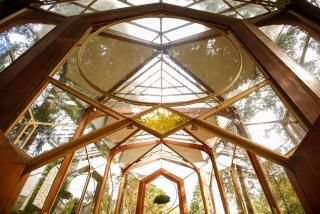What Price, Pray Tell, for Piece of History?
SIMI VALLEY â On a quiet corner in this cityâs oldest neighborhood sits a decaying church, a peeling blue clapboard building straight out of New England, but constructed in the Wild West at the turn of the century.
It seems a forgotten and lonely place: The bell is gone, the doors are barred, the peaked roof is shedding its wooden shingles. A stray cat sprints out of a hole in its side and casts a baleful eye at a rare visitor.
But the sad state of the old St. Rose of Lima, circa 1902, is actually very much on peopleâs minds. The historical society, the park district, the new St. Rose of Lima, all want to preserve Simi Valleyâs oldest church.
âThere is nothing like it around,â said Pat Havens, director of the Strathearn Historical Park.
Armand Banaga, who has owned the building since 1978, concurs. âSimi wouldnât be Simi unless that church was there,â he said.
But thatâs where agreement between the churchâs owner and its suitors ends. No one has offered Banaga a price he can accept yet.
âThe historical society came out a few years ago to try and buy it,â Banaga said. âThey started at $3,000 and kept going up. Iâm still telling them no.â
Havens said the society--along with the park district, which runs the historical park--recently decided to back off attempting to acquire the church, hoping that Banaga can be persuaded instead to donate it to the current St. Rose of Lima in honor of its 75th anniversary.
But Banaga said he canât afford to donate the church; his 35 years of drilling wells for a living havenât provided him with a retirement fund. âAs far as donating it, heck, that would zero me out,â he said. Whatâs more, the church has sentimental value.
âAll through the years I didnât sell it,â he said. âMy father always said, âKeep it in the family.â â
His attachment to the place is deep: He received his First Communion there. His parents--now deceased--celebrated their golden wedding anniversary by renewing their vows in the small church. If he had the money to spend on it, heâd like to fix the place up, he said.
âI donât want to just let it deteriorate,â he said.
Despite the obvious wear of years on the church, its stark lines and angles maintain a simple beauty. A single arched window is framed in the facade, a weathered wooden cross tops off a shingled cupola. A dozen old cypress trees--Banaga remembers them from his childhood in the 1930s--stand at attention next to the entryway, like a reception line at a formal party.
St. Rose was built in 1902 as a Presbyterian church, Havens said. A few years later the Presbyterians combined worship with a Methodist church, leaving the little building at the corner of Pacific and 3rd Avenue empty. Occasionally, services were held there by visiting priests, and in 1921 the church was consecrated and became St. Rose of Lima, a Catholic church.
Johnny Delgado, Banagaâs brother-in-law who helps take care of the church, received his First Communion there in 1930. A faded photograph shows him with his Communion class, standing on the steps of the church with the cypress trees in the background.
Like Delgado, many of the students had come with their families to pick walnuts in the rich valley.
âAfter you pick walnuts for a week or so, you stain your fingers brown,â Delgado remembered, ambling down the street toward St. Rose. He pointed out the cupola, where the bell used to hang.
âThey rang it three times, starting at 9:30,â Delgado said. âYou were supposed to be there at 10. You could hear the bell a mile away because there was no traffic then.â
The bell was removed when Banaga bought the church and was given to longtime congregation member Lucy Chavez. Chavez said her mother and father ordered the bell from Montgomery Ward in Chicago in 1916 and donated it to the church in honor of her sister, who died at 15. Now Chavez keeps the bell at her home, where her great-grandchildren amuse themselves by pushing against its rusted sides to make it toll.
As Simi Valleyâs population grew, Delgado said, the congregation overflowed the little church.
âPeople would be out here for Mass,â he said, standing on the front stoop.
Inside, the church shows signs of a different, more recent history.
Crumpled party masks leer from the floor, eerie reminders of a Halloween past. Duct tape anchors pieces of worn carpet to the narrow slats of a wooden floor. Yellowed posters from bands that once practiced there are tacked to the Sheetrock. Empty beer cans stand atop a metal picnic table pulled up to a sagging floral couch; a homeless personâs impromptu dining room.
âFor a while homeless people were living here,â Delgado said. âBut my brother-in-law had to kick them out. This place could burn so easily.â
Only one pew remains and the organ is long gone. Banaga said the place has been vandalized many times over the years. âEvery Tom, Dick and Harry helped themselves to it,â he said.
What was once the confessional is now a bathroom. Stained tiles block the view of what was once a vaulted ceiling. The back of the room has been divided into several tiny rooms. But the imprint of a cross-shaped altar still shows on the back wall.
Next door, through a backyard planted with grapefruit trees and old willows, is a small house also owned by Banaga. When the church was still in use, before the early 1960s when the new St. Rose of Lima was built, the priest lived in the house. Banaga is renovating it and hopes to sell the church and house as a package.
âI donât know what the value of it really is,â Banaga said. âMy goal is to have an income out of it. That is going to be the bottom line on my retirement.â
More to Read
Sign up for The Wild
Weâll help you find the best places to hike, bike and run, as well as the perfect silent spots for meditation and yoga.
You may occasionally receive promotional content from the Los Angeles Times.






